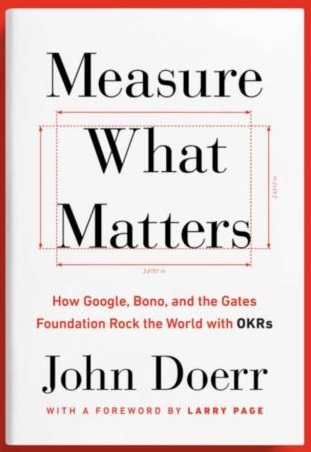Why OKRs Do Not Help Us Measure What Matters
by Stacey Barr |Objectives and Key Results (OKRs) promise to help us measure what matters. But take a closer look, and you’ll see they have little to do with performance measurement.

In the Kindle edition of his book Measure What Matters: OKRs – the Simple Idea That Grows 10x Growth, John Doerr celebrates the simple methodology that he originally learned from Intel legend, Andy Grove, in the 1970s. Doerr shares stories of how OKRs have helped many organisations, including Google, Bono and the Gates Foundation achieve great things.
Doerr gives this basic definition of an OKR, or Objective and Key Result, in his book:
“An OBJECTIVE… is simply WHAT is to be achieved, no more and no less. By definition, objectives are significant, concrete, action oriented, and (ideally) inspirational.”
“KEY RESULTS benchmark and monitor HOW we get to the objective. Effective KRs are specific and time-bound, aggressive yet realistic. Most of all, they are measurable and verifiable.”
Then Doerr shares this first example of an OKR, which was part of his presentation to introduce them to Google, to illustrate his definition. His example was an OKR he set for himself for that presentation:
OBJECTIVE:
Build a planning model for their company:
KEY RESULTS:
(AS MEASURED BY…)
KR #1: Finish the presentation on time.
KR #2: Create a sample set of quarterly Google OKRs.
KR #3: Gain management agreement for a three-month OKR trial.
What do OKRs have to do with measuring what matters?
OKRs are not the way to measure what matters.
In a book called Measure What Matters, I’d expect to find information about how to measure the things that matter, and I’d expect to find examples of meaningful measures. But I found neither.
The book has plenty of long stories about organisations and companies that have used OKRs, and does include a lot of examples of OKRs. But there is little instruction on measuring what matters, and plenty of examples of non-specific objectives, immeasurable key results, and key results that are actions rather than results. Like this one for Intel:
OBJECTIVE:
Demonstrate the 8080’s superior performance as compared to the Motorola 6800.
KEY RESULTS:
(AS MEASURED BY…)
1. Deliver five benchmarks.
2. Develop a demo.
3. Develop sales training materials for the field force.
4. Call three customers to prove the material works.
And this one, from MyFitnessPal:
OBJECTIVE:
Help more people around the world.
KEY RESULTS:
(AS MEASURED BY…)
1. Add 24M new users in 2014.
2. Reach 80M total registered users.
And just one more, from Intuit:
OBJECTIVE:
Deliver awesome end-to-end workforce technology solutions and strategies.
KEY RESULTS:
(AS MEASURED BY…)
1. Implement Box pilot for first 100 users by mid-quarter.
2. Complete BlueJeans rollout to final users by end of the quarter.
3. Transfer first 50 individual account Google users to enterprise account by end of the quarter.
4. Finalize Slack contract by end of month 1 and complete rollout play by end of the quarter.
These examples illustrate the very same problems we all face with how to measure our goals and strategy meaningfully: vague language, action-orientation, mistaking milestones for measurement, and hitting quotas rather than reaching for new and sustained levels of performance.
OKRs are not about measurable results, they are about implementation of actions.
I think what’s happening is that John Doerr and all the supporters of OKRs have different meanings for the words ‘result’ and ‘measure’. Their focus is strongly on implementation of action, not impact.
Every OKR example from the book listed actions instead of results. And it appeared (because it was never specifically articulated) that a measure was just the completion of those actions, or the meeting of a quota of actions.
Sure, there are different types of measures to monitor things. We can certainly use quotas and milestones to monitor progress, but we shouldn’t mistake them for performance measures. The OKR style of monitoring puts focus on implementing actions. Performance measures put focus on improving results. Most organisations already have too much focus on actions and not enough on results.
Why do great companies like Google say that OKRs work?
If OKRs don’t really help us measure what matters, why do these great companies love them so much? What does the OKR method contribute to organisational performance?
There are some common threads through each story in Measure What Matters. And these threads are, I think, what makes OKRs work:
- Each organisation that loves OKRs appears to have a very inspirational and devoted leader, who believes in rallying the troops to work together.
- Each leader who introduces OKRs believes in the power of focus, and ruthlessly prioritising what they give time and resources to.
- The culture of those organisations that benefit from OKRs is one of getting things done.
So the point I really want to make is to consider OKRs as a tool for focused implementation of projects, but not as a tool for meaningful measurement.
If you want more meaningful performance measures, don’t mistake OKRs as a measurement tool.
If you want to have clear goals or objectives that people understand and that you can evidence the achievement of, then:
- write them well, as results and without weasel words
- cascade them through cause-effect logic
If you want meaningful measures that monitor results, then:
- understand what performance measures really are
- design them deliberately rather than brainstorming or defaulting to what’s easy
- monitor them for signals of change over time, in response to your actions
OKRs don’t help us measure what matters. They focus us on implementation, not results.
[tweet this]
DISCUSSION:
Does your organisation use OKRs? What success do you have with measuring in a meaningful way, to drive performance improvement? Or are you monitoring the progress of actions, rather than their results?
Connect with Stacey
Haven’t found what you’re looking for? Want more information? Fill out the form below and I’ll get in touch with you as soon as possible.
167 Eagle Street,
Brisbane Qld 4000,
Australia
ACN: 129953635
Director: Stacey Barr




